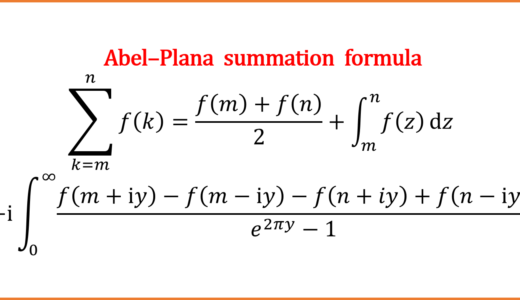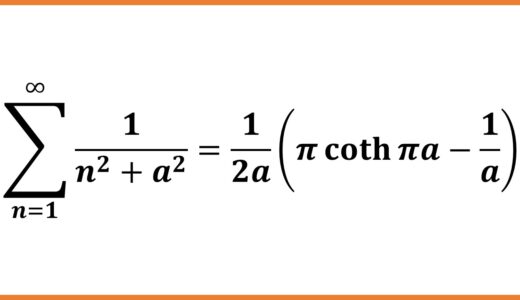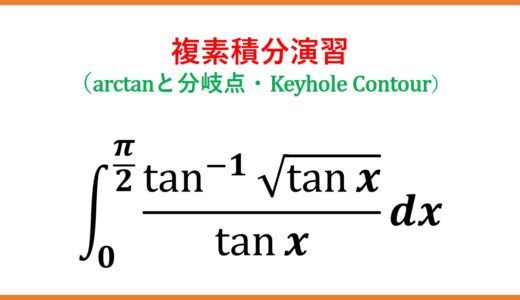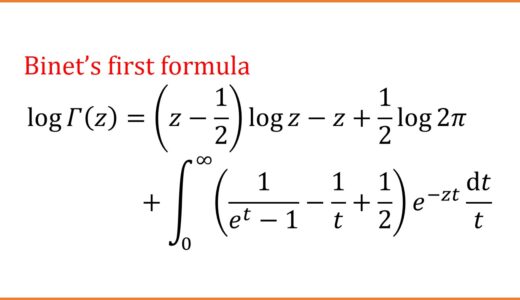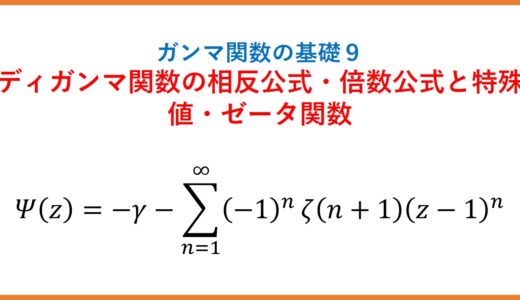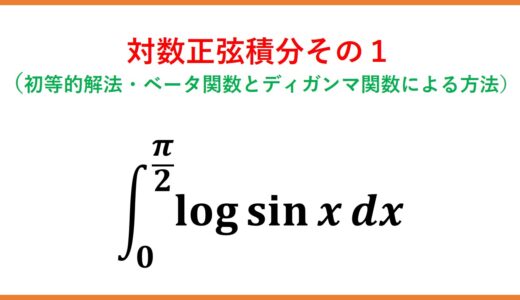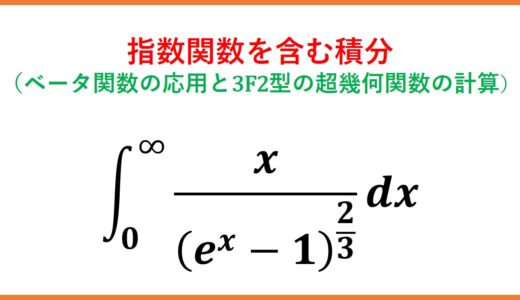Previous posts:
$$I=\int_0^\infty\left(\sqrt{1+x^4}-x^2\right)^sdx$$Let $$y=\left(\sqrt{1+x^4}-x^2\right)^2$$Then,
\begin{eqnarray*}I&&=\frac{1}{4\sqrt{2}}\int_0^1\left[y^{\frac{s}{2}-\frac{5}{4}}(1-y)^{\frac{1}{2}}+2y^{\frac{s}{2}-\frac{1}{4}}(1-y)^{-\frac{1}{2}}\right]dy\\&&=\frac{1}{4\sqrt{2}}\left[B\left(\frac{s}{2}-\frac{1}{4},\frac{3}{2}\right)+2B\left(\frac{s}{2}+\frac{3}{4},\frac{1}{2}\right)\right]\\&&=\frac{1}{4\sqrt{2}}\left[\frac{\G(\frac{s}{2}-\frac{1}{4})\frac{\sqrt{\pi}}{2}}{\G(\frac{s}{2}+\frac{5}{4})}+2\frac{\G(\frac{s}{2}+\frac{3}{4})\sqrt{\pi}}{\G(\frac{s}{2}+\frac{5}{4})}\right]\\&&=\sqrt{\frac{\pi}{2}}\frac{(\frac{1}{2}+s-\frac{1}{2})\G(\frac{s}{2}-\frac{1}{4})}{(2s+1)\G(\frac{s}{2}+\frac{1}{4})}\\&&=\frac{s}{2s+1}\sqrt{\frac{\pi}{2}}\frac{\G(\frac{s}{2}-\frac{1}{4})}{\G(\frac{s}{2}+\frac{1}{4})}\end{eqnarray*}
$$I=\int_0^\infty\frac{\sin sx}{e^{2\pi x}-1}dx$$Abel-Plana formula:\begin{multline}\sum_{k=m}^nf(k)=\frac{f(m)+f(n)}{2}+\int_m^nf(z)dz\\+i\int_0^\infty\frac{f(m+iy)-f(m-iy)-f(n+iy)+f(n-iy)}{e^{2\pi y}-1}dy\end{multline}
Let $f(z)=e^{-sz}$ , $m=0$ , $n=\infty$ , we have$$\sum_{k=0}^\infty e^{-sk}=\frac{1}{2}+\int_0^\infty e^{-sx}dx+i\int_0^\infty\frac{e^{-isy}-e^{isy}}{e^{2\pi y}-1}dy$$Therefore,$$\frac{1}{1-e^{-s}}=\frac{1}{2}+\frac{1}{s}+2\int_0^\infty\frac{\sin sx}{e^{2\pi x}-1}dx$$Hence,$$I=\frac{1}{2}\left(\frac{1}{1-e^{-s}}-\frac{1}{s}-\frac{1}{2}\right)$$
Another solution:
\begin{eqnarray*}I&&=\int_0^\infty\sin sx\sum_{n=1}^\infty e^{-2\pi nx}dx\\&&=\sum_{n=1}^\infty\int_0^\infty e^{-2\pi nx}\sin sx dx\end{eqnarray*}
This integral can be evaluated like this:\begin{eqnarray*}\int_0^\infty e^{-2\pi nx}\sin sx dx&&=\left[-\frac{e^{-2\pi nx}}{2\pi n}\sin sx\right]_0^\infty+\frac{s}{2\pi n}\int_0^\infty e^{-2\pi nx}\cos sx dx\\&&=\left[-\frac{se^{-2\pi nx}}{4\pi^2 n^2}\cos sx\right]_0^\infty-\frac{s^2}{4\pi^2 n^2}\int_0^\infty e^{-2\pi nx}\sin sx dx\end{eqnarray*}Hence,$$\int_0^\infty e^{-2\pi nx}\sin sx dx=\frac{s}{s^2+4\pi^2n^2}$$
\begin{eqnarray*}I&&=\sum_{n=1}^\infty\frac{s}{s^2+4\pi^2n^2}\\&&=\frac{1}{4}\left(\coth\frac{s}{2}-\frac{2}{s}\right)=\frac{1}{2}\left(\frac{1}{1-e^{-s}}-\frac{1}{s}-\frac{1}{2}\right)\end{eqnarray*}
See below about Abel-Plana summatioin formula:
See below about a series formula involving $\coth x$:
$$I=\int_0^\infty x^{s-1}e^{ix}dx$$Consider $$0=\oint_Cz^{s-1}e^{iz}dz$$Contour $C$ starts at the origin, go right along the real axis to $R$, then draw the quadrant of radius $R$ counter-clockwise, go back to the origin along the imaginary axis.\begin{eqnarray*}0&&=\int_0^\infty x^{s-1}e^{ix}dx+\int_0^\frac{\pi}{2}iR^se^{is\t}e^{iR\cos\t-R\sin\t}d\t-e^{\frac{\pi}{2}si}\int_0^\infty y^{s-1}e^{-y}dy\end{eqnarray*}The second integral tends to 0 as $R\to\infty$ when $\mathfrak{R}s<1$.
So we suppose that $\mathfrak{R}s<1$.Then,$$I=e^{\frac{\pi}{2}si}\int_0^\infty y^{s-1}e^{-y}dy=\G(s)e^{\frac{\pi}{2}si}$$Hence,$$\begin{cases}\displaystyle\int_0^\infty x^{s-1}\cos xdx&=&\G(s)\cos\dfrac{\pi s}{2}\\\displaystyle\int_0^\infty x^{s-1}\sin xdx&=&\G(s)\sin\dfrac{\pi s}{2}\end{cases}$$
From @integralsbot$$\int_0^\frac{\pi}{2}\frac{dx}{\sqrt[3]{1+3\sin^2 x}}=\frac{\G^3(\frac{1}{3})}{2^{\frac{7}{3}}\pi}$$PROOF.\begin{eqnarray*}LHS&&=\int_0^\frac{\pi}{2}\frac{dx}{\sqrt[3]{1+3\sin^2 x}}\\&&=\int_0^\frac{\pi}{2}\sum_{n=0}^\infty \left(\frac{1}{3}\right)_n\frac{(-3\sin^2x)^n}{n!}dx\\&&=\sum_{n=0}^\infty \frac{(\frac{1}{3})_n}{n!}(-3)^n\int_0^\frac{\pi}{2}\sin^{2n}xdx\\&&=\frac{\pi}{2}\sum_{n=0}^\infty\frac{(\frac{1}{3})_n(\frac{1}{2})_n}{(1)_n}\frac{(-3)^n}{n!}\\&&=\frac{\pi}{2}F\left(\frac{1}{3},\frac{1}{2},1;-3\right)\end{eqnarray*}Recall Bailey's identity\begin{equation}F\left(a,b,2b;-\frac{4z}{(1-z)^2}\right)=(1-z)^{2a}F\left(a,a-b+\frac{1}{2},b+\frac{1}{2};z^2\right)\tag{1}\end{equation}Let $z=\frac{1}{3}$ , $a=\frac{1}{3}$ , $b=\frac{1}{2}$ to get$$F\left(\frac{1}{3},\frac{1}{2},1;-3\right)=\left(\frac{2}{3}\right)^{\frac{2}{3}}F\left(\frac{1}{3},\frac{1}{3},1;\frac{1}{9}\right)$$Moreover, recall a formula deduced here, namely\begin{equation}F\left(a,\frac{1-a}{2},\frac{3a+5}{6};\frac{1}{9}\right)=\left(\frac{3}{4}\right)^\frac{a}{2}\frac{\G(\frac{3a+5}{6})\G(\frac{2}{3})}{\G(\frac{3a+4}{6})\G(\frac{5}{6})}\tag{2}\end{equation}After setting $a=\frac{1}{3}$, duplication formula and reflection formula gives$$F\left(\frac{1}{3},\frac{1}{3},1;\frac{1}{9}\right)=\frac{3^\frac{2}{3}\G^3(\frac{1}{3})}{4\pi^2}$$ Therefore,$$\int_0^\frac{\pi}{2}\frac{dx}{\sqrt[3]{1+3\sin^2 x}}=\frac{\G^3(\frac{1}{3})}{2^{\frac{7}{3}}\pi}$$
We can find (1) in:
Bailey.W.N, Products of generalized hypergeometric series (1928)
Brychkov.Y.A, Handbook of Special Functions: Derivatives, Integrals, Series and Other Formulas (2008)
Bateman.H, Eldélyi.A, Higher Transcendental Functions (1953)
And (2) in:
Brychkov.Y.A, Handbook of Special Functions: Derivatives, Integrals, Series and Other Formulas (2008)
Karlsson.P.W, On two hypergeometric summation formulas conjectured by Gosper (1986)
@AlbahariRicardo obtained the same result in so ellegant way. See here.
\begin{eqnarray*}I&&=\int_0^\infty\frac{\cos 2bx}{\cosh ax}dx\\&&=2\int_0^\infty\frac{e^{-ax}\cos 2bx}{1+e^{-2ax}}dx\\&&=2\int_0^\infty e^{-ax\cos2bx}\sum_{n=0}^\infty(-e^{-2ax})^ndx\\&&=2\sum_{n=0}^\infty(-1)^n\int_0^\infty e^{-(2n+1)ax}\cos2bxdx\end{eqnarray*}The rightmost side is evaluated by integration by parts twice then,$$\int_0^\infty e^{-(2n+1)ax}\cos2bxdx=\frac{(2n+1)a}{(2n+1)^2a^2+4b^2}$$Hence,\begin{eqnarray*}I&&=2a\sum_{n=0}^\infty\frac{(-1)^n(2n+1)}{(2n+1)^2a^2+4b^2}\\&&=\frac{\pi^2}{2a}\sum_{n=0}^\infty\frac{(-1)^n(2n+1)}{\pi^2(n+\frac{1}{2})^2+\frac{b^2}{a^2}\pi^2}\end{eqnarray*}Using the series representation of $\mathrm{sech} z$:$$\mathrm{sech} \:z=\pi\sum_{n=0}^\infty\frac{(-1)^n(2n+1)}{\pi^2(n+\frac{1}{2})^2+z^2}$$We obtain$$I=\frac{\pi}{2a}\mathrm{sech}\:\frac{b}{a}\pi$$
$$I\equiv\int_0^\frac{\pi}{2}\frac{\arctan\sqrt{\tan x}}{\tan x}dx$$
proof here:
\begin{eqnarray*}I&&=\int\frac{1+x^2}{1+x^4}dx\\&&=\frac{1}{2}\int\left(\frac{1}{x^2+\sqrt{2}x+1}+\frac{1}{x^2-\sqrt{2}x+1}\right)dx\\&&=\frac{1}{2}\int\frac{dx}{(x+\frac{1}{\sqrt{2}})^2+\frac{1}{2}}+\frac{1}{2}\int\frac{dx}{(x-\frac{1}{\sqrt{2}})^2+\frac{1}{2}}\\&&=\frac{\arctan(\sqrt{2}x+1)+\arctan(\sqrt{2}x-1)}{\sqrt{2}}+C\\&&=\frac{1}{\sqrt{2}}\arctan\frac{\sqrt{2}x}{1-x^2}+C\end{eqnarray*}
\begin{eqnarray*}I&&=\int_0^\infty\frac{\arctan x}{x^{\log x+1}}dx&&=\int_0^1\frac{\arctan x}{x^{\log x+1}}dx+\int_1^\infty\frac{\arctan x}{x^{\log x+1}}dx\end{eqnarray*}Replace $x\to\dfrac{1}{x}$ in the second term ,then since $\arctan\frac{1}{x}=\frac{\pi}{2}-\arctan x$ ,$$I=\frac{\pi}{2}\int_0^1\frac{dx}{x^{\log x+1}}$$Substitute $x=e^{-y}$, we have$$I=\frac{\pi}{2}\int_0^\infty e^{-y^2}dy$$Therefore,$$\int_0^\infty\frac{\arctan x}{x^{\log x+1}}dx=\frac{\pi^{\frac{3}{2}}}{4}$$
$$I=\int_0^\infty\left(\frac{1}{2}-\frac{1}{x}+\frac{1}{e^x-1}\right)\frac{e^{-x}}{x}dx$$Binet's first formula:$$\log\G(z)=\left(z-\frac{1}{2}\right)\log z-z+\frac{1}{2}\log2\pi+\int_0^\infty\left(\frac{1}{e^t-1}-\frac{1}{t}+\frac{1}{2}\right)e^{-zt}\frac{dt}{t}$$Substitute $z=1$, we obtain$$0=-1+\frac{1}{2}\log2\pi+I$$Hence,$$I=1-\frac{1}{2}\log2\pi$$
Proof of Binet's first formula:
Another solution:$$I=\int_0^\infty\left(\frac{1}{2}-\frac{1}{x}+\frac{1}{e^x-1}\right)\frac{e^{-x}}{x}dx$$
Define $\mu(x)$ in $x>0$ by $$\mu(x)\equiv\log\G(x)-\left(x-\frac{1}{2}\right)\log x+x-\frac{1}{2}\log2\pi$$We can see below easily$$\mu(x)-\mu(x+1)=\left(x+\frac{1}{2}\right)\log\left(1-\frac{1}{x+1}\right)+1$$Using $\log(1-X)=-X-\frac{X^2}{2}-\frac{X^3}{3}-\cdots$, we have\begin{eqnarray*}\mu(x)-\mu(x+1)&&=\sum_{n=1}^\infty\frac{2x+1}{2n(x+1)^n}-1\\&&=\sum_{n=1}^\infty\left(\frac{1}{n(x+1)^{n-1}}-\frac{1}{2n(x+1)^n}\right)\\&&=\frac{1}{2}\sum_{n=1}^\infty\frac{n}{(n+1)(n+2)(x+1)^{n+1}}\end{eqnarray*}Take the sum of $x$ , $x+1$ , $x+2$ , $\cdots, x+N-1$ and use $\lim_{N\to\infty}\mu(x+N)=0$, we get\begin{eqnarray*}\mu(x)&&=\frac{1}{2}\sum_{n=1}^\infty\left[\frac{n}{(n+1)(n+2)}\sum_{k=0}^{\infty}\frac{1}{(x+k+1)^{n+1}}\right]\\&&=\frac{1}{2}\sum_{n=1}^\infty\left[\frac{n}{(n+1)(n+2)}\frac{1}{n!}\sum_{k=0}^{\infty}\int_0^\infty t^ne^{-(x+k+1)t}dt\right]\\&&=\frac{1}{2}\sum_{n=1}^\infty\left[\left(\frac{2}{n+2}-\frac{1}{n+1}\right)\frac{1}{n!}\int_0^\infty e^{-xt}\frac{t^n}{e^t-1}dt\right]\\&&=\frac{1}{2}\int_0^\infty\left[\frac{2}{t^2}\sum_{n=0}^\infty\frac{t^{n+2}}{n!(n+2)}-\frac{1}{t}\sum_{n=0}^\infty\frac{t^{n+1}}{(n+1)!}\right]\frac{e^{-xt}dt}{e^t-1}\\&&=\int_0^\infty\left(\frac{1}{2}-\frac{1}{t}+\frac{1}{e^t-1}\right)\frac{e^{-xt}}{t}dt\end{eqnarray*}Hence,$$I=\mu(1)=1-\frac{1}{2}\log2\pi$$
detailed text here:
\begin{eqnarray*}I&&=\int_0^\infty\frac{xdx}{\sqrt[3]{(e^{3x}-1)^2}}\\&&=-\frac{1}{9}\int_0^1t^{-\frac{1}{3}}(1-t)^{-\frac{2}{3}}\log tdt\quad(e^{-3x}=t)\\&&=-\frac{1}{9}\left.\dd{B(x,y)}{x}\right|_{x=\frac{2}{3},y=\frac{1}{3}}\\&&=-\frac{1}{9}B\left(\frac{2}{3},\frac{1}{3}\right)\left[\psi\left(\frac{2}{3}\right)-\psi(1)\right]\\&&=-\frac{1}{9}\frac{\pi}{\sin\frac{\pi}{3}}\left(-\g-\frac{3}{2}\log3+\frac{\pi}{2\sqrt{3}}+\g\right)\\&&=\frac{\pi}{3\sqrt{3}}\left(\log 3-\frac{\pi}{3\sqrt{3}}\right)\end{eqnarray*}
About $\psi(2/3)$:
About the derivative of the beta function:
$$I=\int_0^\infty\frac{x}{(e^x-1)^\frac{2}{3}}dx$$
Thanks to @BenriBot_ccbs. He told me about an amazing substitution! $$I\equiv \int_0^1\frac{\arctan x}{\sqrt{x(1-x^2)}}dx$$Substituting $x\to\frac{1-x}{1+x}$, we have$$I=\int_0^1\frac{\arctan\frac{1-x}{1+x}}{\sqrt{x(1-x^2)}}dx$$Adding these two $I$s,\begin{eqnarray*}2I&&=\int_0^1\frac{\arctan x+\arctan\frac{1-x}{1+x}}{\sqrt{x(1-x^2)}}dx\\&&=\int_0^1\frac{\frac{\pi}{4}}{\sqrt{x(1-x^2)}}dx\end{eqnarray*}Hence,\begin{eqnarray*}I&&=\frac{\pi}{8}\int_0^1\frac{dx}{\sqrt{x(1-x^2)}}\\&&=\frac{\pi}{16}\int_0^1y^{-\frac{3}{4}}(1-y)^{-\frac{1}{2}}dy\quad(x=\sqrt{y})\\&&=\frac{\pi}{16}B\left(\frac{1}{4},\frac{1}{2}\right)\\&&=\frac{\pi}{16}\frac{\sqrt{\pi}\G(\frac{1}{4})}{\G(\frac{3}{4})}\\&&=\frac{\sqrt{2\pi}\G^2(\frac{1}{4})}{32}\end{eqnarray*}
If we expand to the series,\begin{eqnarray*}I&&=\frac{1}{2}\int_0^1y^{-\frac{3}{4}}(1-y)^{-\frac{1}{2}}\arctan\sqrt{y}dy\\&&=\frac{1}{2}\int_0^1y^{-\frac{3}{4}}(1-y)^{-\frac{1}{2}}\sum_{n=0}^\infty\frac{(-1)^n}{2n+1}y^{n+\frac{1}{2}}dy\\&&=\frac{1}{2}\sum_{n=0}^\infty\frac{(-1)^n}{2n+1}\int_0^1y^{n-\frac{1}{4}}(1-y)^{-\frac{1}{2}}dy\\&&=\frac{1}{2}\sum_{n=0}^\infty\frac{(-1)^n}{2n+1}B\left(n+\frac{3}{4},\frac{1}{2}\right)\\&&=\frac{\sqrt{\pi}}{2}\sum_{n=0}^\infty\frac{(-1)^n}{2n+1}\frac{\G(n+\frac{3}{4})}{\G(n+\frac{5}{4})}\\&&=\frac{2\sqrt{\pi}\G(\frac{3}{4})}{\G(\frac{1}{4})}{}_3F_2\left[\begin{matrix}1,\frac{1}{2},\frac{3}{4}\\\frac{3}{2},\frac{5}{4}\end{matrix};-1\right]\\&&=\frac{\pi}{4}{}_3F_2\left[\begin{matrix}\frac{1}{2},\frac{1}{2},\frac{3}{4}\\\frac{3}{2},1\end{matrix};1\right]\end{eqnarray*}Then we get an identity about ${}_3F_2$,$${}_3F_2\left[\begin{matrix}\frac{1}{2},\frac{1}{2},\frac{3}{4}\\\frac{3}{2},1\end{matrix};1\right]=\frac{\sqrt{2}\G^2(\frac{1}{4})}{4\sqrt{\pi}}$$
Next post:
Please support me!

記事を気に入って下さった方、「応援してあげてもいいよ」という方がいらっしゃったら15円から可能なので支援していただければ幸いです。情報発信を継続していくため、サーバー維持費などに充てさせていただきます。
ご支援いただいた方は、こちらで確認できます。
◎ Amazonギフトの場合、
Amazonギフト券- Eメールタイプ – Amazonベーシック
より、金額は空白欄に適当に(15円から)書きこんで下さい。受取人は「mamekebiamazonあっとgmail.com」です(あっとは@に置き換えてください)。贈り主は「匿名」等でOKです。全額がクリエイターに届きます。
◎ OFUSEは登録不要で、100円から寄付できます。金額の90%がクリエイターに届きます。
OFUSEで応援を送る◎ codocは登録不要で、100円から寄付できます。金額の85%がクリエイターに届きます。

